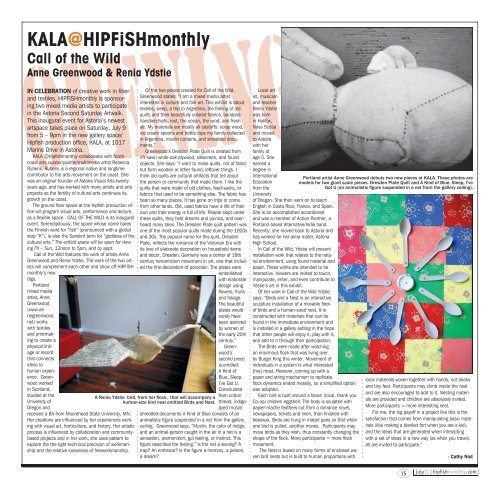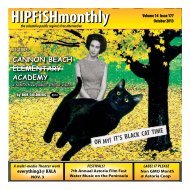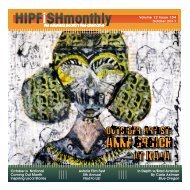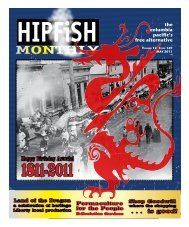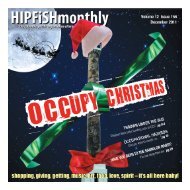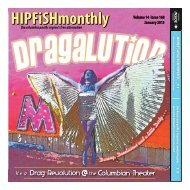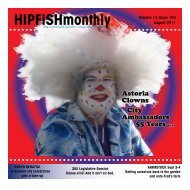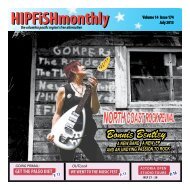continued from page 12projects around the Astoria area. Afteremploying neighbors to help buildhis house, which fits in well with theVictorian/Craftsman architecture ofthe neighborhood, Kennedy has donemany cabinet and other woodworkinstallations around town in betweenbigger projects. He currently has ahouse he designed and built for saleat 10th and Grand in Astoria. (Checkout his web site at http://www.blindmoseswoodworking.com/for detailsif you’re interested.) The recessionhas made homebuilding tough, butBlind Moses is nonetheless doingOK. Kennedy showed me plans andprototypes for a springy bench at hisshop, and he’s always thinking of newideas to try.Kennedy’s latest big project wasthe repurposing of the old Lovell Autobuilding and the construction of anoutdoor patio to the Fort George restaurantand various other upgrades tothe Fort George block, now owned byJack Harris and Chris Nemlowill. Thecanning operationand new tap roomin the Lovell buildingwere great examplesof “learning on thejob” and “gettingthe job done,” Kennedytold me. Givena tight budget anda lot of leeway, heworked with ownersJack Harris andChris Nemlowill andmany others to createAstoria’s latestindustrial enterprise.Kennedy has aknack for findingmaterials that canbe repurposed in hisprojects. Some ofthe ceiling beamsin his house arefrom pilings from oldcanneries in the Astoriaarea. The FortGeorge project usedtimbers from thebuilding at 10th andCommercial that burned on Thanksgivingnight in 2008 in the outdoorpatio railings, “the world’s most elaborategarbage shed” doors, and mostimpressively, in the new tap room inthe Lovell building. “I found them (30twenty-foot timbers) laying in a pile,”said Kennedy, who was tipped off byMitch Mitchum, the owner of the nowhistorically-renovated building.Harris and Nemlowill acquired a 30barrel brewhouse from Saint ArnoldBrewing Company of Houston, Texas,and purchased a state of the artcanning operation from Cask BrewingSystems in Calgary, Canada earlierthis year. Kennedy’s job was to makeit all work, and that required learninga lot about brewing. That’s been atheme for him throughout his career.”The walls of the canning area aremade of corrugated metal, that wasused in the painting of the Astoria-Megler Bridge. They give the placesome industrial warehouse character,and the price was right. Coppertubing from the brewing equipmentbecame handrails. In the large coolerthat keeps the canned beer cold andready to distribute, Kennedy usedmetal panels that also came with thebrewing equipment. This cooler wasoffice space when the building was anauto shop.During the 7-month project, Kennedylearned all about not only brewingbeer, but also about the historyof the Lovell Building from the Lovellfamily and friends. The building usedto house 12 businesses, including amovie theater on the upper floor. Theowners haven’t yet decided what toRe-purposed copper and steeldo with the parts of the building notbeing used for canning, but Kennedythinks the second floor should sport aroller derby arena. “Wouldn’t that becool!” he exclaimed.The tour ended with a visit to thebathrooms, which are vintage. ButKennedy’s proudest achievement onthe project? “You’ve got to see thepig,” he pleaded. “My artistic contributionto the operation!” Yes, thereit was, a barley storage tank with anattitude. The best touch is the groundwire that was fashioned into a pigtail.Not only does Kennedy get the jobdone, he has fun doing it!Bright blue and silver cans of 1811 Lager, and the beautiful,magical spinning hop of the Vortex IPA (both designed byJosh Berger of id branding and longtime friend of Jack Harris)are now showcased at Fred Meyer in Warrenton. A long,tall cooler stacked with fresh FGB beer is ready to quench asummer’s thirst.The question arises; with all this expansion is the wonderduo of Harris and Nemlowill ready to overtake craft brew inAmerica?“We want to get beer to everybody in Oregon who wantsit -- hopefully to the Seattle area by next summer. We haveestablishments calling from Seattle, “What do I have to doto get your beer? We can’t make enough right now to fillorders,” says Nemlowill.Increasing production and filling more orders is a matter ofthe fermentation process. Nemlowill informs that two morefermentors are in the works. “This size brewery is perfect. It isbig enough so that you get enough consistency in your beer,and its not so big that your beer losses its character. “But the 50 states are not in these brew masters manufacturingprojection.“It doesn’t make sense to ship water. It’s not good for theenvironment for people to ship water all over the United States.Why steep your tea on the west coast and ship it to the east coast?Steep your tea where you are going to drink it. As long as we cankeep the quality high on our product, this is the criteria for shipping.”Harris and Nemlowill are also setting a new precedent. Theywant to keep their product regional, based on what they are creating.That precedent is one they are making in the Oregon craft brewThe Tap Room, Lovell Building. OPen Fri 3-8pm, Sat 1-8pm, SunNonn-5pm. Enter through the Fort George Parking Lot, or 14thStreet.Brewery Tours: Saturday and Sundays @ 1pm & 4pm25 cans per minute, fresh from the tank.community. Cans of FGB, must be kept cold, never warm-stored,and must be sold within 60 days of delivery. It is not a safetyprecaution – it’s a quality requirement. Craft brew after 60 days, isnot the brew they painstakingly craft to stimulate the beer lover’ssenses. FGB just invested in a very expensive can labeler, whichputs the quality date on the bottom of the can. Cans of 1811 lagerand Vortex IPA are the only beers sitting in the back storage dairycooler in grocery stores about Oregon. Serious passion.“We believe in our beer – we know how much work we put into it– we know the quality of the ingredients. We want people to experiencethis,” states Nemlowill resolutely. “We pull the beer if it’s pastthe date. Then it goes into the black box.”Tim Ensign, is FBG’s top dog sales rep, whose beer career coversthe gamut, from working for Sierra Nevada Bottling, to TraderJoes, and large beer distribution companies. Even Ensign at firstwas dubious as to how retailers would respond to this very uniquepolicy, but customer by customer, Nemlowill states, “It’s creatingdistributors who are beginning to appreciate the quality edge.”“I feel lucky to go out and sell something that is higher qualitythan what anybody else can sell to that customer. It feels good tohave that competitive advantage. It is also a competitive edge forour customers. “Nemlowill is an advocate for more people doing small manufacturingin Astoria, and he says, “It’s the best way to have completecontrol over your products.” And local jobs are a cherished andever-valued commodity.If part of your product is serving the public, Fort George is nowslouch at that either. The public house is jammed to the brim anygiven night of the week. The service is amazingly good in a packed,music-filled, lively house. Young, hipster waiters don’t flinch at acrabby customer, whom may peruse what’s on tap or take in thegorgeous chalk art on not one, but two expansive boards createdby a bevy of coastal artists.Beer in a can is what you get on draft – basically a keg is justa big can, giving the consumer the freshest, most pure brew possible.And cans, as opposed to bottles, protect beer from light andoxygen. Cans are airtight and oxygen-free. When light consistentlyhits a bottle of beer, it can turn skunky and ultimately undrinkable.Yuck. Cans too, are more easily recyclable.The canning of the two brews is the current ticket, but Nemlowillsays, eventually they’ll be looking at several more styles to add tothe canning line in the future, this with the inclusion of seasonalspecialties. They also love to hear from customers as to what theymay want to have in the can.While the can played a huge role in the economy and history ofAstoria, as commercial canners were mad to get rich on shippingsalmon and tuna to the demanding consumer public, it also playeda part in depleting the resources. This can renaissance has a newvalue structure. We “can” romanticize and celebrate history, but ifwe pay attention, a new kind of prosperity is on the horizon. Thriveon Fort George. Lets tip up our cans and drink to that!Every SUNDAY LIVE MUSICWhen Fort George started the LIVE music on Sundays, part of the missionwas to provide entertainment on an otherwise usual slow night. Not competingwith other venues. Seemed an improbable audience.Who would have thought that people, really needing to get out of the house,now just bring their kids with them for a beer and to end the weekend.So Don’t Miss Atomic Duo from Austin TX, fronted by Bad Livers originatorMark Rubin, July 24. 8pm, No Cover.july11 hipfishmonthly.com14
<strong>KALA</strong>@<strong>HIPFiSHmonthly</strong>openingCall of the WildAnne Greenwood & Renia YdstieIN CELEBRATION of creative work in fi berand textiles, <strong>HIPFiSHmonthly</strong> is sponsoringtwo mixed media artists to participatein the Astoria Second Saturday Artwalk.This inaugural event for Astoria’s newestartspace takes place on Saturday, July 9from 5 – 9pm in the new gallery space/Hipfi sh production offi ce, <strong>KALA</strong>, at 1017Marine Drive in Astoria.<strong>KALA</strong> @Hipfi shmonthly collaborates with Northcoastarts curator/painter/multimedia artist RebeccaRubens. Rubens is a regional native and longtimecontributor to the arts movement on the coast. Shewas an original founder of Astoria Visual Arts twentyyears ago, and has worked with many artists and artsprojects as the fertility of cultural arts continues itsgrowth on the coast.The ground fl oor space at the hipfi sh production office will program visual arts, performance and lecture,as a fl exible space. CALL OF THE WILD is its inauguralevent. Serendipitously, the space whose name baresthe Finnish word for “fi sh” (pronounced with a glottalstop “K”), is also the Sanskrit term for “goddess of thecultural arts.” The exhibit space will be open for viewingFri – Sun, 12noon to 5pm, and by appt.Call of the Wild features the work of artists AnneGreenwood and Renia Ydstie. The work of the two artistswill complement each other and show off HIPFISHmonthly’s newdigs.Portlandmixed mediaartist, AnneGreenwood(www.annegreenwood.net) workswith textilesand printmakingto create aphysical linkageor recordthat connectsideas tohuman experience.Greenwoodworkedin Scotland,studied at theUniversity ofOregon andreceived a BA from Moorehead State University, MN.Her creations are infl uenced by her experiences workingwith visual art, horticulture, and history. Her artisticprocess is infl uenced by collaboration and communitybasedprojects and in her work, she uses pattern toexplore the the tight technical precision of workmanshipand the relative looseness of freeworkmanship.Of the two pieces created for Call of the Wild,Greenwood states: “I am a mixed media artistinterested in culture and folk art. This exhibit is abouttextiles, sleep, a trip to Argentina, the feeling of oldquilts and their beautifully colored fabrics, bandanahandkerchiefs, rest, the ocean, the wind, and freshair. My materials are mostly all castoffs: scrap wood,ice cream spoons and bottle tops my family collectedin Argentina, muslin curtains, and shredded documents.”Greenwood’s Dresden Plate Quilt is created fromrift-sawn white oak plywood, silkscreen, and foundobjects. She says: “I want to make quilts, not of fabricbut form wooden or other found, leftover things. Ithink old quilts are cultural artifacts that tell aboutthe person or community that made them. I like thequilts that were made of old clothes, feed-sacks, orfabrics that used to be something else. The fabric hasbeen so many places. It has gone on trips or comefrom other lands. Old, used fabrics have a life of theirown and their energy is full of life. People slept underthese quilts, they held dreams and picnics, and overheardmany tales. The Dresden Plate quilt pattern wasone of the most popular quilts made during the 1920sand 30s. The popular name for this quilt, DresdenPlate, refl ects the romance of the Victorian Era withits love of elaborate decoration on household itemsand décor. Dresden, Germany was a center of 19thcentury romanticism movement in art, one that includedthe fi ne decoration of porcelain. The plates wereembellishedwith elaboratedesign usingfl owers, fruitsand foliage.The beautifulplates wouldsurely havebeen admiredby women ofthe early 20thcentury.”Greenwood’ssecond pieceis entitled:A Kind ofBlue, Sleep,I’ve Got U.Constructedfrom cottonthread, indigodyedmuslinshredded documents A Kind of Blue consists of ananimalistic fi gure suspended in a net from the galleryceiling. Greenwood says, “Muslin, the color of indigo,and an animal-person caught in the air in a net is asensation, premonition, gut feeling, or instinct. Thisfi gure describes the feeling.” Is the net a sieving? Atrap? An embrace? Is the fi gure a memory, a person,a dream?A Renia Ydstie bird, from her flock, that will accompany ahuman-size bird nest entitled Birds and Nest.Local artist,musicianand teacherRenia Ydstiewas bornin Halifax,Nova Scotiaand movedto Astoriawith herfamily atage 5. Sheearned adegree inInternationalEducationfrom theUniversityof Oregon. She then went on to teachEnglish in Costa Rica, France, and Spain.She is an accomplished accordionistand was a member of Action Panther, aPortland-based Alternative/Indie band.Recently, she moved back to Astoria andhas worked for her alma mater, AstoriaHigh School.In Call of the Wild, Ydstie will presentinstallation work that relates to the naturalenvironment, using found material andpaper. These works are intended to beinteractive. Viewers are invited to touch,manipulate, enter, and even contribute toYdstie’s art in this exhibit.Of her work in Call of the Wild Ydstiesays: “Birds and a Nest is an interactivesculpture installation of a movable fl ockof birds and a human-sized nest. It isconstructed with materials that can befound in the immediate environment andis installed in a gallery setting in the hopethat other people will enjoy it, play with it,and add to it through their participation.The Birds were made after watchingan enormous fl ock that was living overby Burger King this winter. Movement ofindividuals in a system is what interested[me] most. However, coming up with apaper and string mechanism to replicatefl ock dynamics ended messily, so a simplifi ed optionwas adopted.Each bird is built around a blown (local, thank youCo-op) chicken eggshell. The body is sculpted withpapier-mache feathers cut from a romance novel,newspapers, tickets and linen, then fi nished withbeeswax. Birds are hung in mated pairs so that whenone bird is pulled, another moves. Participants maymove birds as they wish, thus constantly changing theshape of the fl ock. More participants = more fl ockmovement.The Nest is based on many forms of enclosed wovenbird nests but is built to human proportions withPortland artist Anne Greenwood debuts two new pieces at <strong>KALA</strong>. These photos aremodels for two giant scale pieces. Dresden Plate Quilt and A Kind of Blue, Sleep, I’veGot U (an animalistic figure suspended in a net from the gallery ceiling).local materials woven together with hands, not beaksand tiny feet. Participants may climb inside the nestand are also encouraged to add to it. Nesting materialsare provided and children are absolutely invited.More participants = more interesting nest.For me, the big payoff in a project like this is thesatisfaction that comes from manipulating basic materials(like making a blanket fort when you are a kid),and the ideas that are generated when interactingwith a set of ideas in a new way (as when you travel).All are invited to participate.”- Cathy Nist15 july11 hipfishmonthly.com


